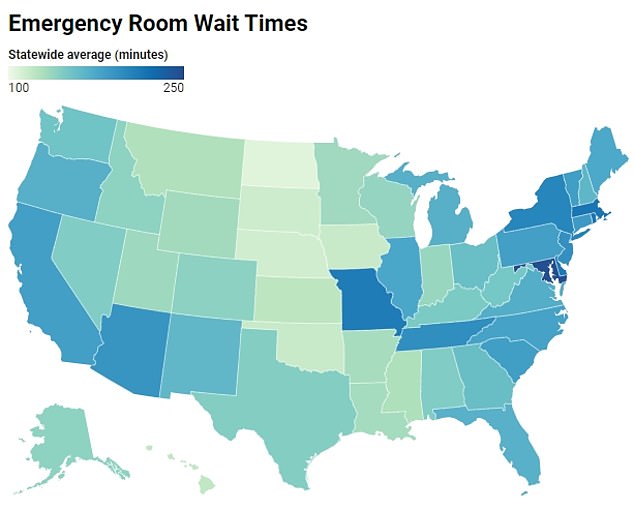As healthcare workers face historically high rates of burnout, the impact of America’s troubled hospital system is trickling down to waiting rooms.
Patients across the country face exceptionally long wait times in emergency departments (EDs), with patients in some states waiting more than four hours for treatment.
The average duration of patients from the time they first check in to the ED to the time they are sent home from the hospital varies widely across the country.
In areas with fast departments, they can see you in one hour and forty minutes, while in more delayed areas it is more than four hours.
Aside from the inconvenience, long wait times can lead to life-threatening complications and endanger patients’ health.
The average time spent in the emergency department nationwide before being discharged is two hours and 45 minutes.
But nearly half of U.S. states exceed this figure, with Maryland having the longest hospital wait times: 247 minutes, just over four hours.
Your browser does not support iframes.

Tied for second are Massachusetts and Rhode Island with 214 minutes.
Delaware (211 minutes), New York (202 minutes) and New Jersey (194 minutes) round out the top five, according to data from the Centers for Medicare & Medicaid Services, analyzed by pre-deal legal financing firm High Rise Financial.
Spending more time in the emergency department increases the chances of complications such as infections and the risk of patients leaving before receiving treatment.
The bottom five states, where patients can expect to be in and out of the ED in two hours or less, include North Dakota (107 minutes), Nebraska (114 minutes), South Dakota (115 minutes), Oklahoma and Iowa ( 117 minutes). ) and Hawaii (120 minutes).
Long emergency department wait times have plagued hospitals for years. A study conducted more than a decade ago found that longer durations were associated with a higher risk of hospital admission or death within seven days.
Although the overall risk is low, the risk of hospital admission increased by up to 95 percent, while the risk of death increased by up to 79 percent among the sickest patients.
An independent 2018 study found that long ED wait times are associated with increased deaths and lower patient satisfaction.
Dr. LouAnn Giangreco, a board-certified emergency physician and medical director of American Family Care, a network of urgent care clinics, told DailyMail.com that emergency wait times are often a sign of the overall health ecosystem of An area.
He said the length of stay in an ED “really depends on the entire health ecosystem that surrounds that emergency department,” which includes resources in the community and access (or lack thereof) to preventive care services.
When the surrounding area lacks reliable or quality everyday healthcare services, “the emergency department becomes a safety net” for all conditions, including non-emergent ones.
As burnout among healthcare professionals skyrocketed during the Covid pandemic, hospitals felt the effects of staff and supply shortages.
Dr Giangreco said: ‘The other extreme is what is happening within the hospital system.
‘If that hospital system has a limit on the number of beds it has, it prevents people from being able to go to the hospital to be treated.
“That’s why they’re kept in the emergency department for care when they really need to be on the hospital floor.”
In addition to the lack of routine care, Dr. Giangreco said mental health in the ED is becoming an increasingly common problem.
Part of the overall nature of the emergency department is that people who come in with behavioral health issues have limited access to care in the community, leading to overcrowding in waiting rooms.
To address the problem and improve care, Dr. Giangreco emphasized the importance of being able to access routine preventive care, which would maintain a person’s health and decrease the chances that a complication would require a trip to the emergency department.
Increasing telehealth and urgent care services can also provide faster and more accessible intermediate healthcare.
Supporting doctors, nurses, and advanced practice professionals (APPs) to avoid burnout and leave hospital systems is vital to reducing ED wait times and improving patient care.
Maryland leads the country with the longest ER wait times and is a state that is no stranger to topping the charts when it comes to hospitals or healthcare, according to a previous DailyMail.com report.
Dangerous medical errors resulting in death or serious injury tripled in hospitals across the state between 2019 and 2022.
A state report showed there were 832 adverse events from Oct. 1, 2021, to Sept. 30, 2022, which was also the highest since records began in 2004.
Of the incidents, 769 were classified as the most serious, or Level 1 events, defined as adverse incidents that result in death or serious disability.
In one case, a patient underwent surgery on one leg and ended up having the other amputated due to a serious medical complication.
In another case, in 2021, three people died after a maintenance worker inadvertently shut off an unlabeled oxygen line.
Another blunder involved a low-birth-weight premature baby receiving the wrong dose of steroids for nearly two weeks.
Overall events in 2022 represented a 52 percent increase over 2021, and the highest the state has recorded since it began collecting data in 2004.
The report, which partially attributed the increase in adverse events to reduced staffing and supply shortages during the Covid-19 pandemic, included results from 62 hospitals across the state of Maryland, but did not indicate in which hospitals the events occurred. events.
The Leapfrog Group, a private organization that evaluates hospital safety metrics, ranked Maryland 35th in patient safety and only gives nine hospitals in the state its highest safety rating, Level A.
Overall events in 2022 represented a 52 percent increase over 2021, and the highest the state has recorded since it began collecting data in 2004.
The report, which partially attributed the increase in adverse events to reduced staffing and supply shortages during the Covid-19 pandemic, included results from 62 hospitals across the state of Maryland, but did not indicate in which hospitals the events occurred. events.
The Leapfrog Group, a private organization that evaluates hospital safety metrics, ranked Maryland 35th in patient safety.
The agency only gives nine hospitals in the state its highest safety rating, Level A.
Based on the findings, the report’s authors emphasized that hospitals must prioritize safety and optimize processes to avoid system failures that could lead to serious errors.
It also leads Maryland in Alzheimer’s disease rates.
The state of Maryland ranks first for the highest rate of Alzheimer’s disease in the United States, even though it fares better in obesity rates, household income, and residents with health insurance.
The traditionally Democratic state located next to the nation’s capital has more than one in eight people over age 65 with the condition, compared to about one in 10 nationally.
Maryland is also the only state to have two counties with the 10 highest rates of Alzheimer’s.
Baltimore City was tied for first with 16.6 percent of people over 65 and Prince George’s County was fourth with 16.1 percent.
Dr. Kumar Rajan, author of the first report on county-level Alzheimer’s rates published in The Journal of the Alzheimer’s Association last year, said the prevalence of the disease in Maryland is due to a higher number of black and Hispanic residents. .
These minority groups may have high rates of dementia, health experts say, because they have a higher incidence of heart disease, diabetes and high blood pressure, all conditions that affect brain health.
Previous research has shown that older black Americans are twice as likely to have Alzheimer’s or other dementias as older whites, and older Hispanics are about 1.5 times more likely to have the disease than their white counterparts due to confounding factors. comorbidities and social aspects, such as racism. and discrimination.
In addition to co-occurring medical conditions, the Alzheimer’s Association said the higher prevalence of the disease among blacks and Hispanics can likely be explained by social and health disparities, as well as the marginalization and discrimination of these groups in the United States, which has been deeply rooted in History.
Dr. Keith Vossel, director of the Alzheimer’s disease program in the department of neurology at the University of California, Los Angeles, previously told DailyMail.com that marginalized groups experience stress, violence, discrimination and racism. All of these life experiences can influence epigenetic changes, which alter the way a gene is expressed.
While Dr. Giangreco couldn’t say definitively why Maryland is experiencing the highest wait times, she said it’s important to examine a hospital’s staffing, quality measures and errors to get to the root cause. and start addressing it.

